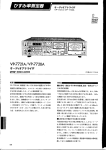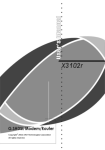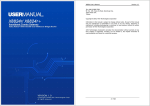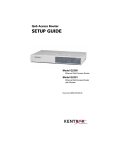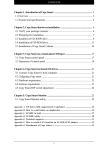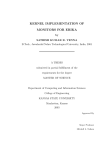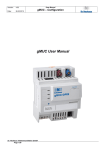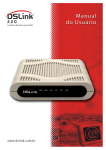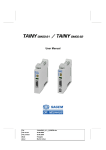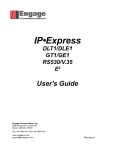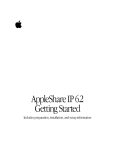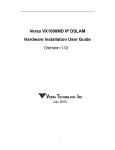Download X7721r/X7721r+ User`s Manual Version 1.0
Transcript
+ X7721r/X7721r User’s Manual Version 1.0 -1- + X7721r/X7721r User’s Manual Version 1.0 XAVi Technologies Corporation Tel: +886-2-2995-7953 9F, No. 129, Hsing Te Road, Sanchung City, Taipei Hsien 241, Taiwan Copyright © 2003, XAVi Technologies Corporation Information in this manual is subject to change without notice. No part of this manual may be reproduced or transmitted in any form or by any means, electronic or mechanical, including photocopying or scanning, for any purpose, without the written permission of XAVi Technologies Corporation. XAVi Technologies Corporation provides this documentation without warranty of any kind, implied or expressed, including, but not limited to, the implied warranties of merchantability and fitness for a particular purpose. -2- + X7721r/X7721r User’s Manual Version 1.0 Table of Contents Chapter 1 – Getting Started I. II. III. IV. V. Overview…………………………………….………….……….……… 6 Features…………………………………………………………..…….. 7 Packaging……………………………………….…….………………… 8 Safety Guidelines………………………………………………………. 9 Appearance…………………………………..………………….…….. 10 Front Panel…………………………………………………….……..…10 Rear Panel………………………………………………………..…… 11 VI. Hardware Installation…………………………………………………. 12 VII. Management…………………..………………..…..…….…………... 13 VIII. Default Values…………….……..……………………………………. 14 IX. Software Upgrade……………………..……………………………… 15 Chapter 2 – Command Line Interface I. II. Console Setup..…………….………….………………..….…..…….. 17 CLI Commands……...……………………………..…………………. 18 1. Main Menu Commands…………………………………………. 18 2. LAN Menu Commands…….…………..………………….…… 21 Chapter 3 – Web Management Interface I. II. Overview……………………………………………………………. 22 Preparation…………………………………………………………. 22 1. Login………………………………………………………………. 23 2. Connection Settings………………….………………………….. 24 2.1 RFC 1483 Bridge……..……………..………….………….. 25 2.1.1 RFC 1483 Bridge with NAT……………….……… 27 2.2 RFC 1483 Route………..………..……………….…………29 2.3 PPP over ATM (PPPoA)…………………………………… 31 2.4 PPP over Ethernet (PPPoE)…..………….……….……… 33 2.5 IP over ATM (IPoA).……….…………..…………..………. 35 3. Advanced Settings………………..………..………….………… 37 3.1 NAPT (Network Address Port Translation)……….……… 37 3.2 Static Routes……………………………………….……….. 38 3.3 DNS Relay…………………………………………………... 40 3.4 Security….…………………………………………………... 41 3.4.1 Security state………………………………………….41 3.4.2 Security level……....………………………………….42 3.4.3 Security interfaces...………………………………….43 -3- + X7721r/X7721r User’s Manual Version 1.0 Table of Contents 4. 5. 6. 3.4.4 Policies, Triggers, Intrusion Detection..…………….44 3.4.4.1 Security Policy Configuration……………….45 3.4.4.2 Security Triggers…………….……………….49 3.4.4.3 Intrusion Detection…………..……………….50 3.4.4.4 Default Security Policies…………………….51 System Settings………………………………………………….. 52 4.1 Local LAN IP………………………………………………… 52 4.2 DHCP Server……………………………………………….. 53 4.3 Management………………………………………………… 54 4.3.1 Edit User Details…………….……………………...54 4.3.2 Add Users……………..……………………………. 55 4.3.3 Delete Users………….………..…..………..……...56 4.4 Ethernet……………………………………………………… 57 Modem Status……………….……………………….…….…….. 58 Maintenance…………………..…………………………..……… 60 6.1 Error Log…………………………………………………….. 60 6.2 Modem Upgrade………….………………………………… 61 6.3 Backup/Restore………………..…………………………… 61 6.4 Restart……………………………………………………….. 62 6.5 Save………………………………………………………….. 62 Appendix A – Specifications A1. A2. Hardware Specifications..…………………………………….………….. 63 Software Specifications……….…………………………….…………….64 Appendix B – Warranties B1. B2. B3. Product Warranty……………………………..………………………….. 65 Warranty Repair………………………………………………………….. 66 Out-of-Warranty Repair………………………………………………….. 66 Appendix C – Regulations C1. C2. C3. FCC Part 15 Notice…………………………………….……………….. 67 IC CS-03 Notice………..………………………………..………………... 68 UL Safety Regulations...………………………………..………………... 69 Contact Information……………………………………………………….… 70 -4- + X7721r/X7721r User’s Manual Version 1.0 Revision Marks Revision V 1.0 Date December 12, 2003 Notes Software Version: 1.02XAT0.7721A -5- + X7721r/X7721r User’s Manual Version 1.0 Chapter 1 Getting Started I. Overview The X7721r/X7721r+ is a multi-mode ADSL/ADSL2 router, which complies with ANSI T1.413 Issue 2, ITU G.992.1 (X7721r/X7721r+), ITU G.992.2, G.992.3, G.992.4, G.992.5 (X7721r+ only), Annex A, and ETSI ITS 101388 ADSL standards. The X7001r+ supports ADSL2+ as well. The X7001r/X7721r+ provides high-speed Internet access via one WAN port over ATM over ADSL, and also connects to the corporate network via a 10/100BaseT Ethernet port. It supports multiple protocols such as PPP (RFC 2364), IP (RFC 2225/RFC 1577), and RFC 1483 over ATM over ADSL, and PPP (RFC 2516) over Ethernet. X7001r/X7001r+ offers convenient configuration and management locally by telnet, SNMP, and a web-browser through the Ethernet interface, and remotely through the ADSL interface. -6- + X7721r/X7721r User’s Manual Version 1.0 II. Features High Speed Asymmetrical Data Transmission on Twisted Copper Pair Wire Service providers can deploy ADSL rapidly over existing wire infrastructure (POTS or ISDN line) Interchangeable between Bridge and Router mode RFC 1483 Bridge and Routing over ATM over ADSL PPPoE, and IPoA, and PPPoA Routing over ADSL 10/100BaseT Ethernet Port for PC/LAN connection High quality, simple operation, and low power consumption Compatible and interoperable with most central office side ADSL DSLAM or Multi-service Access Systems Local OAM&P through command line interface via RS-232 craft port Configuration and management with Telnet through the Ethernet interface, and remote Telnet through ADSL interface Firmware upgradeable through TFTP, HTTP Interoperability complies with TR-48 -7- + X7721r/X7721r User’s Manual Version 1.0 III. Packaging This package consists of the following items: X7721r/X7721r+ ADSL device unit RJ-45 Cable RJ-11 Cable AC Adapter User’s Manual CD -8- + X7721r/X7721r User’s Manual Version 1.0 IV. Safety Guidelines In order to reduce the risk of fire, electric shock and injury, please adhere to the following safety guidelines. Carefully follow the instructions in this manual; also follow all instruction labels on this device. Except for the power adapter supplied, this device should not be connected to any other adapters. Do not spill liquid of any kind on this device. Do not place the unit on an unstable stand or table. This unit may drop and become damaged. Do not expose this unit to direct sunlight. Do not place any hot devices close to this unit, as they may degrade or cause damage to the unit. Do not place any heavy objects on top of this unit. Do not use liquid cleaners or aerosol cleaners. Use a soft dry cloth for cleaning. -9- + X7721r/X7721r User’s Manual Version 1.0 V. Appearance Front Panel 12 1 2 3 4 5 3 45 Label LED Status Color 100M ON Green 10M ON Green 10M Ethernet transmitting. PWR ON Green Power supply is connected. WAN Blinking Green Training with DSLAM. ON Green ADSL link is ready. Blinking RED Booting up. ON RED Error. ALM - 10 - Description 100M Ethernet transmitting. + X7721r/X7721r User’s Manual Version 1.0 Rear Panel 1 1 2 3 4 2 Label PWR ETHERNET RESET WAN 3 4 Description Power jack; connect to a power adapter. RJ-45 port; connect to a PC or LAN. Reset the modem back to factory settings by holding down on this button. RJ-11 port; connect to the ADSL outlet. - 11 - + X7721r/X7721r User’s Manual Version 1.0 VI. Hardware Installation 1. Connect one end of the ADSL cable to the WAN port of X7721r/X7721r+ and the other end to the ADSL wall outlet. 2. Use a RJ-45 cable to connect one end to the Ethernet port of X7721r/X7721r+ and the other end to the LAN or a PC with an Ethernet adapter installed. 3. Plug in the AC adapter to the AC power socket, and then connect the DC jack to the PWR inlet of X7721r/X7721r+. 2 PC 3 Power Supply 1 ADSL Outlet Note: Be sure to use a RJ-45 crossover cable while connecting to a hub. - 12 - + X7721r/X7721r User’s Manual Version 1.0 VII. Management Console Port – use the RS-232 cable for connecting X7721r/X7721r+ to a console terminal or a PC running a terminal emulation program, such as Hyper Terminal. (For further details, See Chapter 2: Command Line Interface) Local Ethernet Port (telnet) – connect the Ethernet port to your local area network or directly to a PC, “Telnet” X7721r/X7721r+ from any workstation in the LAN. The default local Ethernet IP address is “192.168.1.1”. Local Ethernet Port (web-browser) – connect the Ethernet port to your local area network or directly to a PC. Launch your web browser and enter default local Ethernet IP address “192.168.1.1” into the address bar. ADSL Port from Remote Site – while the ADSL connection is in service, you may remotely “Telnet” X7721r/X7721r+ from a workstation connected to the CO equipment. Note: As operating an ADSL device requires technical know-how and experience, it is recommended that only qualified technical staff manage X7721r/X7721r+. Therefore, a password authentication is required when you enter the command line and Web interface. See the Default Values section to obtain the password. - 13 - + X7721r/X7721r User’s Manual Version 1.0 VIII. Default Values X7721r/X7721r+ is pre-configured with the following parameters; you may also re-load the default parameters by typing Restore in the command line interface or using the Restart link in the Web interface. Default Mode: Bridge Username/Password: admin Bridge Mode Setting WAN and ADSL Ethernet (local) IP: 192.168.1.1 Local Line Code: Multi-mode Subnet Mask: 255.255.255.0 Trellis Mode: Enable Full Duplex: Auto FDM Mode: Fdm Protocol: RFC1483, Bridge Mode Coding Gain: Multi VPI/VCI: 8/35 Transmit Power Attenuation: 0dB Class (QoS): UBR Spanning Tree: Disable Packet Filter: Any Router Mode Setting DHCP Server: Disable Ethernet (local) IP: 192.168.1.1 DNS Relay: Disable Subnet Mask: 255.255.255.0 Full Duplex: Auto Note: The Username and Password are case-sensitive. - 14 - + X7721r/X7721r User’s Manual Version 1.0 IX. Software Upgrade You may easily upgrade X7721r/X7721r+ embedded software by obtaining the compressed upgrade kit from the service provider and then following the steps for upgrading through either a DOS prompt or a Web-browser: Software upgrade through a DOS prompt Step 1. Extract the ZIP file for updated firmware. Step 2. Connect X7721r/X7721r+ via the local Ethernet port or remote ADSL link, making sure that the X7721r/X7721r+ Ethernet IP address and your terminal are properly configured so that you can successfully “ping” X7721r/X7721r+. The default local IP address is “192.168.1.1”. Step 3. Under the DOS prompt, execute the command “xupgrade <IP address of X7721r/X7721r+ >”, for instance, “xupgrade 192.168.1.1”. Step 4. This upgrading process may last as long as 60 seconds. Step 5. Reboot X7721r/X7721r+ with new software. Note: Strictly maintain stable power to X7721r/X7721r+ while upgrading its software. If the power fails during the upgrading process, contents in the memory could be destroyed, and the system may hang. In such a case, you must call the dealer or system integrator for repairs. - 15 - + X7721r/X7721r User’s Manual Version 1.0 Software upgrade through a Web-browser Step 1. Extract the ZIP file for updated firmware. Step 2. Connect X7721r/X7721r+ via the local Ethernet port or remote ADSL link, making sure that the X7721r/X7721r+ Ethernet IP address and your terminal are properly configured so that you can successfully “ping” X7721r/X7721r+. The default local IP address is “192.168.1.1”. Step 3. Launch the Web browser (IE or Netscape), and enter the default IP address 192.168.1.1 into the address bar to access the Web management page. Step 4. Click on the Maintenance link in the navigation bar and then on the Modem Upgrade link below it. Step 5. Click on the Browse button to select the upgrade file. Step 6. Click on the Update button when completed. Note: Strictly maintain stable power to X7721r/X7721r+ while upgrading its software. If the power fails during the upgrading process, contents in the memory could be destroyed, and the system may hang. In such a case, you must call the dealer or system integrator for repairs. - 16 - + X7721r/X7721r User’s Manual Version 1.0 Chapter 2 Command Line Interface I. Console Setup Connect the RS-232 console port to an ASCII data terminal or a PC with Windows serial Terminal mode of VT-100 (Hyper Terminal). To Start the Hyper-terminal, follow the steps below. 1. Start "Hyper-terminal" program On Windows 98 or Windows NT: Click on the Start button Programs Accessories Hyper Terminal Group Double Click “Hypertrm.exe” Enter a Connection Name Select Icon Click OK 2. Select a COM port to communicate with X7721r/X7721r+ Choose Direct to COM1 or Direct to COM2 and click on OK 3. Set Port Properties Port Setting: Bit per second: 9600 Data bits: 8 Parity bits: None Stop bits: 1 Flow Control: None Settings: Function, arrow, and ctrl keys act as: Windows keys Emulation: Auto-detect Back-scroll buffer lines: 500 ASCII Setup: Echo typed characters locally: enable Line delay: 0 milliseconds Character line feeds incoming line ends: enable - 17 - + X7721r/X7721r User’s Manual Version 1.0 III. CLI Commands 1. Main Menu Commands Type “?” following the “→” to retrieve a list of commands under the main menu to begin the configuration. Command Syntax Description / Parameters Display Lan → display → lan Restart Restore Ping → restart → restore → ping <ipAddress> Save → save Displays the configuration of IP Enters the LAN menu (See LAN Menu commands for more details) Reboots the modem Sets all configurations to default Pings the specified IP address for testing purposes Saves the current configuration DISPLAY Displays the IP address, subnet mask and software version. Syntax: display → display Version : 1.02XAT0.7721A (1.02XAT0.7721A 09/Dec/2003 16:50) IP Interface: iplan Ipaddr : 192.168.1.1 Mask : 255.255.255.0 → LAN Enters the lan menu Syntax: lan → lan lan> - 18 - + X7721r/X7721r User’s Manual Version 1.0 RESTART Restarts the modem. Syntax: restart → restart NBfs1Z PP Boot 9.0.3.19 (28 July 2003) Copyright (c) 2003 GlobespanVirata, Inc. SDRAM size = 0x1000000 NP i 0% i 4% i 8% i 13% i 17% i 22% i 27% i 31% i 36% i 41% i 46% i 51% i 57% i 62% i 66% i 71% i 76% i 83% i 90% i 100% Login: - 19 - + X7721r/X7721r User’s Manual Version 1.0 RESTORE Sets all configurations to factory default settings. Syntax: restore → restore Restoring factory defaults... → PING Pings a specified IP address. Syntax: ping <ipAddress> Example: ping 192.168.0.81 → ping 192.168.1.1 ping: PING 192.168.1.1: 32 data bytes ping: 40 bytes from 192.168.1.1: seq=0, ttl=128, rtt<10ms192.168.0.81 → SAVE Saves the current configuration. Syntax: save → save Wait for 'configuration saved' message... Saving configuration... Configuration saved. → - 20 - + X7721r/X7721r User’s Manual Version 1.0 2. LAN Menu Commands Type “lan” following the “→” to enter the LAN menu. Command setip Syntax Description / Parameters lan→ setip <ipAddresss> [<subnet mask>] Configures IP settings SETIP Configures the IP address and subnet mask of X7721r/X7721r+. Syntax: setip <ipaddress>[<subnet mask>] Example: setip 192.168.1.10 255.255.255.0 lan> setip 192.168.1.10 255.255.255.0 lan> - 21 - + X7721r/X7721r User’s Manual Version 1.0 Chapter 3 Web Management Interface I. Overview The Web Management Interface is provided in order to configure X7721r/X7721r+ as easily as possible. It provides a user-friendly graphical interface through a Web platform. You may configure bridge or router functions to accommodate your device needs. In the section below, each configuration item is described in detail. II. Preparation 1. Please refer to the hardware installation procedure in Chapter 1 to install X7721r/X7721r+. 2. You should configure your PC to the same IP subnet as the X7721r/X7721r+. Example: X7721r/X7721r+: 192.168.1.1 Your PC: 192.168.1.x 3. Connect your PC to X7721r/X7721r+ and make sure that the PING function is working properly. The default IP address of this device is 192.168.1.1 4. Launch the Web browser (IE or Netscape), and enter the default IP address 192.168.1.1 into the address bar to access the Web management page. 5. The Login dialog box will appear first. - 22 - + X7721r/X7721r User’s Manual Version 1.0 1. Login The Enter Network password window will pop up when starting the configuration. With the window active, type admin for both User name and Password, and then click on the OK button. You can also edit the username and password or add a new profile (see section 4.3 Management for further details). - 23 - + X7721r/X7721r User’s Manual Version 1.0 2. Connection Settings Click on the Connection Settings link on the navigation bar. This page lists the WAN connection protocols that are available on this device. Please read the following instructions for creating each type of WAN connection. You can create multiple WAN connections for each of following protocols: 2.1 RFC 1483 Bridge 2.1.1 RFC 1483 Bridge with NAT 2.2 RFC 1483 Route 2.3 PPP over ATM (PPPoA) 2.4 PPP over Ethernet (PPPoE) 2.5 IP over ATM (IPoA) - 24 - + X7721r/X7721r User’s Manual Version 1.0 2.1 RFC 1483 Bridge Click on the Create new connection service link to display the types of service available. Select RFC1483 Bridge and then click on the Go to next step button. - 25 - + X7721r/X7721r User’s Manual Version 1.0 You will then see the following screen: VPI: Enter the VPI value into this box. VCI: Enter the VCI value into this box. Qos: Select the quality of service level from the menu Encapsulation: Select LLC or VC-Mux from the menu. Connection type: Select RFC1483 Bridge. Packet Filter: Select the packet filter type from the menu. Click on the Create this new service button to complete the configuration. - 26 - + X7721r/X7721r User’s Manual Version 1.0 2.1.1 RFC 1483 Bridge with NAT Click on the Create new connection service link to display the types of service available. Select RFC 1483 Bridge and then click on the Go to next step button. - 27 - + X7721r/X7721r User’s Manual Version 1.0 You will then see the following screen. Be sure to select RFC1483 Bridge with NAT for Connection type. VPI: Enter the VPI value into this box. VCI: Enter the VCI value into this box. Qos: Select the quality of service level from the menu Encapsulation: Select LLC or VC-Mux from the menu. Connection type: Select RFC1483 Bridge with NAT. DHCP Client: Check this box if you would like the device to receive its IP address from a DHCP server (if you select this option, you do not need to enter an IP address or subnet mask). IP Address: Enter the IP address of the device (if not using the device as a DHCP client). IP Subnet Mask: Enter the subnet mask of the IP address (if not using the device as a DHCP client). Click on the Create this new service button to complete the configuration. - 28 - + X7721r/X7721r User’s Manual Version 1.0 2.2 RFC 1483 Route Click on the Create new connection service link to display the types of service available. Select RFC 1483 Route and then click on the Go to next step button. - 29 - + X7721r/X7721r User’s Manual Version 1.0 You will then see the following screen: VPI: Enter the VPI value into this box. VCI: Enter the VCI value into this box. Qos: Select the quality of service level from the menu. Encapsulation: Select LLC or VC-Mux from the menu. DHCP Client: Check this box if you would like the device to receive its IP address from a DHCP server (if you select this option, you do not need to enter an IP address or subnet mask). IP Address: Enter the IP address of the device (if not using the device as a DHCP client). IP Subnet Mask: Enter the subnet mask of the IP address (if not using the device as a DHCP client). Click on the Create this new service button to complete the configuration. - 30 - + X7721r/X7721r User’s Manual Version 1.0 2.3 PPP over ATM (PPPoA) Click on the Create new connection service link to display the types of service available. Select PPP over ATM and then click on the Go to next step button. - 31 - + X7721r/X7721r User’s Manual Version 1.0 You will then see the following screen: VPI: Enter the VPI value into this box. VCI: Enter the VCI value into this box. Qos: Select the quality of service level from the menu. Authentication: Select PAP or CHAP. Username: Enter the user name for this connection (from ISP). Password: Enter the password for this connection (from ISP). Idle time: Enter a number for the idle time in seconds. This will end the call if the connection is idle for the specified time (0 indicates that the call will not be ended). Click on the Create this new service button to complete the configuration. - 32 - + X7721r/X7721r User’s Manual Version 1.0 2.4 PPP over Ethernet (PPPoE) Click on the Create new connection service link to display the types of service available. Select PPP over Ethernet and then click on the Go to next step button. - 33 - + X7721r/X7721r User’s Manual Version 1.0 You will then see the following screen: VPI: Enter the VPI value into this box. VCI: Enter the VCI value into this box. Qos: Select the quality of service level from the menu. Authentication: Select PAP or CHAP. Username: Enter the user name for this connection (from ISP). Password: Enter the password for this connection (from ISP). Idle time: Enter a number for the idle time in seconds. This will end the call if the connection is idle for the specified time (0 indicates that the call will not be ended). Click on the Create this new service button to complete the configuration. - 34 - + X7721r/X7721r User’s Manual Version 1.0 2.5 IP over ATM (IpoA) Click on the Create new connection service link to display the types of service available. Select IP over ATM and then click on the Go to next step button. - 35 - + X7721r/X7721r User’s Manual Version 1.0 You will then see the following screen: VPI: Enter the VPI value into this box. VCI: Enter the VCI value into this box. Qos: Select the quality of service level from the menu. DHCP Client: Check this box if you would like the device to receive its IP address from a DHCP server (if you select this option, you do not need to enter an IP address or subnet mask). IP Address: Enter the IP address of the device (if not using the device as a DHCP client). IP Subnet Mask: Enter the subnet mask of the IP address (if not using the device as a DHCP client). Click on the Create this new service button to complete the configuration. - 36 - + X7721r/X7721r User’s Manual Version 1.0 3. Advanced Settings Click on the Advanced Settings link on the navigation bar. This section includes NAPT (Network Address Port Translation), Static Routes, and DNS Relay. Each section is described in detail below. 3.1 NAPT (Network Address Port Translation) Click on the NAPT link in the navigation bar to view the NAPT configuration page. This page displays the NAT status of the available connections. To enable NAT on an interface, click on the Enable NAT to internal interfaces button. To disable NAT on an interface, click on the Disable NAT to internal interfaces button. - 37 - + X7721r/X7721r User’s Manual Version 1.0 You may map a port to an interface by clicking on the Add Reserved Mapping link under the Disable NAT to internal interfaces button. You will then see the following screen: Internal IP Address: Enter the IP address to which you would like to map a protocol and port. Transport Type: select a protocol from the drop-down list. Port: Enter the port number of that protocol. Click on the Add Reserved Mapping button when completed. 3.2 Static Routes Click on the Static Routes link in the navigation bar to view the IP Routing table. Click on the Create new IP4 Route button to add a new route. - 38 - + X7721r/X7721r User’s Manual Version 1.0 You will then see the following screen: Destination: Enter the IP Address of the destination router. Gateway: Enter the IP Address of the gateway. Mask: Enter the subnet mask of the IP address. Metric: Enter the number of hops required to reach the destination. Click on the Add Static Route button when completed. - 39 - + X7721r/X7721r User’s Manual Version 1.0 3.3 DNS Relay Click on the DNS Relay link in the navigation bar to view the DNS Relay table. Enter the Primary DNS address into the text box and then click on the Apply button. On the next screen, you may add a Secondary DNS address into the text box. Click on the Apply button to continue. To delete a DNS address, check the Delete? box, and click on the Apply button. - 40 - + X7721r/X7721r User’s Manual Version 1.0 3.4 Security Click on the Security link in the navigation bar to view or change the security interface settings. 3.4.1 Security State Use the toggle switch to enable or disable Security, Firewall, and Intrusion Detection. Click on the Change State button to apply the new settings. Configurations for advanced security settings will apply only if Security is enabled in the Security State section. Configurations for security policies and intrusion detection will apply only if Firewall is enabled in the Security State section. Configurations for intrusion detection will apply only if Intrusion Detection is enabled in the Security State section. - 41 - + X7721r/X7721r User’s Manual Version 1.0 3.4.2 Security Level You must set Firewall to Enabled in order to choose a security level. Choose a value for Security Level from the drop-down menu. Click on the Change State button to apply the new settings. - 42 - + X7721r/X7721r User’s Manual Version 1.0 3.4.3 Security Interfaces This table lists the name, type, and NAT status of each security interface. To enable NAT on an interface, click on the Enable NAT to internal interfaces button. To disable NAT on an interface, click on the Disable NAT to internal interfaces button. To map a port to an interface, click on the Advanced NAT Configuration link under the Disable NAT to internal interfaces button. Choose the Add Reserved Mapping link on the next screen. See the Add Reserved Mapping section (next page) for instructions. To delete an interface, click on the Delete Interface link in the corresponding row. To add another interface, click on the Add Interface link below the table. - 43 - + X7721r/X7721r User’s Manual Version 1.0 Add Reserved Mapping Internal IP Address: Enter the IP address to which you would like to map a protocol and port. Transport Type: select a protocol from the drop down list. Port: Enter a port number for the selected protocol. Click on the Add Reserved Mapping button when completed. 3.4.4 Policies, Triggers, and Intrusion detection To configure security policies, security triggers, or intrusion detection, choose the corresponding link. - 44 - + X7721r/X7721r User’s Manual Version 1.0 3.4.4.1 Security Policy Configuration To add a new security policy, choose the Security Policy Configuration link, and then choose the New Policy link on the next screen. You will then see the following screen: Choose the types of interfaces from the menus between which you would like to configure the security policy. Choose whether the validators (selection criteria) will serve to block or allow traffic. Click on the Apply button. You will then see the following screen: To configure a new policy, click on the Port Filters link and/or the Host Validators link in the Current Security Policies table. To delete a security policy, click on the Delete button in the corresponding row of the Current Security Policies table. - 45 - + X7721r/X7721r User’s Manual Version 1.0 Port Filters To set the port filters, click on the Port Filters link in the Current Security Policies table. On the next screen, choose Add TCP or UDP Filter or Add Raw IP Filter link depending on the type of filter you want to create. Add TCP or UDP Filter Enter the criteria for the port filter into the table. Ensure that the Protocol is appropriate for your interface. Port filter default values for “allow” criteria will allow all traffic to pass (as shown in this example). Port filter default values for “block” criteria will block all traffic. Filter criteria for source and destination ports define the range within which traffic will be allowed/blocked by the filter. Filter criteria for source and destination addresses and subnet masks do not override port criteria, but add additional criteria for the port filter. Click on the Apply button to return to the list of defined port filters. To delete a port filter, click on the Delete button of the corresponding row of the port filters table. - 46 - + X7721r/X7721r User’s Manual Version 1.0 Add Raw IP filter Enter the criteria for the port filter into the table. Default values for “allow” criteria will allow all traffic to pass (as shown in this example). Default values for “block” criteria will block all traffic. Enter the IP Protocol that the security interface will allow. Filter criteria for source and destination IP addresses and subnet masks define the values that will be allowed by the “allow” filter, and define the values that will be blocked by the “block” filter. Filter criteria for source and destination IP address and subnet mask do not override IP protocol criteria, but add additional criteria for the port filter. Click on the Apply button to return to the list of defined port filters. To delete a port filter, click on the Delete button of the corresponding row of the port filters table. - 47 - + X7721r/X7721r User’s Manual Version 1.0 Host Validators To set the host validators, click on the Host Validators link in the Current Security Policies table. On the next screen, choose the Add Host Validator link . You will then see the following screen: Enter the IP Address and subnet mask for the host that you want to have validated. Indicate whether the host address should be validated for incoming traffic, outgoing traffic, or both by selecting a value from the Direction drop-down box. Packets from the host address that you enter in the host validator will be blocked or allowed according to the way the validator was defined when the interface was created. Click on the Apply button to return to the list of defined host validators. To delete a host validator, click on the Delete button of the corresponding row of the host validators table. - 48 - + X7721r/X7721r User’s Manual Version 1.0 3.4.4.2 Security Triggers Security triggers can be defined on the following interfaces: External and internal External and DMZ DMZ and internal To add a new security trigger, choose the Security Trigger Configuration link, and then choose the New Trigger link on the next screen. You will then see the following screen: Enter values into the table to define the new security trigger. The security trigger adds traffic flow constraints to the security policies. The security trigger remains active even when the firewall is disabled. Click on the Apply button to return to the list of defined security triggers. To delete a security trigger, click on the Delete button of the corresponding row of the security triggers table. - 49 - + X7721r/X7721r User’s Manual Version 1.0 3.4.4.3 Intrusion Detection Intrusion detection can be defined on any interface with an external endpoint. To configure firewall intrusion detection, choose the Configure Intrusion Detection link. Firewall intrusion detection can be configured only if Intrusion Detection is enabled in the Security State section. You will then see the following screen: Enter values into the table to set conditions for intrusion detection. If Use Blacklist is set to true, clicking on the Clear Blacklist button will clear the blacklist. Click on the Apply button to save the settings. - 50 - + X7721r/X7721r User’s Manual Version 1.0 3.4.4.4 Default Security Policies Default security policies, including port filters and security triggers, are defined for the low, medium, and high security levels. For example, if the High security level is selected, security policies for every type of interface are already defined, as shown below. Each security policy applies only if its corresponding interface is defined by the user. The pre-defined security settings for any security level include port filter settings and security trigger settings. To override the pre-defined settings, you can delete the policies, port filters, or security triggers as required. User-defined host validators for pre-defined security policies will act to block traffic by default. - 51 - + X7721r/X7721r User’s Manual Version 1.0 4. System Settings Click on the System Settings link on the navigation bar. This section includes Local LAN IP, DHCP Server, Management, and ADSL. Each section is described in detail below. 4.1 Local LAN IP Click on the Local LAN IP link in the navigation bar to view the LAN IP table. Define the primary IP address and subnet mask of your device here, and make changes by editing the IP address in the text box. Click on the Apply button to save the configurations. - 52 - + X7721r/X7721r User’s Manual Version 1.0 4.2 DHCP Server Click on the DHCP Server link in the navigation bar to view the DHCP Server settings. This device can be set up to perform the service of a DHCP Server and enables data connection between multiple PCs through the configuration of IP address ranges and lease times. Enable DHCP server: Make sure that you check this box if you would like this device to function as a DHCP server. Starting IP address: Enter the IP address that you would like the DHCP server to start assigning addresses from. Ending IP address: Enter the last IP address that you would like the DHCP server to assign. Lease duration: Enter the amount of time that an IP address can be used by a client. Primary DNS address: Enter the Primary DNS IP address. Secondary DNS address: Enter the Secondary DNS IP address. Use Router as Default Gateway: Make sure that you check this box if you would like this device to be the default gateway. Click on the Apply button when completed. - 53 - + X7721r/X7721r User’s Manual Version 1.0 4.3 Management Click on the Management link in the navigation bar to view the user login details. Here you may edit user login details or add/delete users. Each item is described below. 4.3.1 Edit User Details Click on the Edit link to change the settings of the admin user. On this page you may change the settings of the admin user. Username: Enter a new username if you would like to change this one. Password: Enter a new password if you would like to change this one (highly recommended for security purposes). May Login?: Do not change this setting to false, otherwise you will not be able to log into the device. Comment: You may add a comment/description here. Click on the Edit this User button to complete this configuration. - 54 - + X7721r/X7721r User’s Manual Version 1.0 4.3.2 Add Users Click on the Create new user link to add a user. On this page you may fill in the details for the new user. Username: Enter a new username for the new user. Password: Enter a password for the new user. May Login?: Do not change this setting to false, otherwise you will not be able to log into the device. Comment: You may add a comment/description here. Click on the Create this User button to complete this configuration. You will then see the new user added to the table. - 55 - + X7721r/X7721r User’s Manual Version 1.0 4.3.3 Delete Users In order to delete an existing user, click on the Delete link next to the user’s name. You will then be asked to confirm if you would like to delete this user. Click on the Delete this User button. - 56 - + X7721r/X7721r User’s Manual Version 1.0 4.4 Ethernet Click on the Ethernet link on the navigation bar. This page displays a table of the default Ethernet settings. This includes port, configuration, linked status, and speed/duplex. You can choose a value for speed/duplex from the drop-down menu. Click on the Change button to save the changes. - 57 - + X7721r/X7721r User’s Manual Version 1.0 - 58 - + X7721r/X7721r User’s Manual Version 1.0 5. Modem Status Click on the Modem Status link on the navigation bar. You will then see the following page. Listed on this page are the port connection status, LAN status, WAN status, ADSL status, and device status. - 59 - + X7721r/X7721r User’s Manual Version 1.0 LAN Status: This table displays the LAN IP address, and indicates whether this device is used as a DHCP server. Click on the Detail… link to view the LAN statistics. This page displays the MAC address and transfer statistics. WAN Status: This table displays the WAN IP address. Click on the Detail… link to view the WAN statistics. ADSL Status: This table displays the operation status and firmware version. Device Status: This table displays the device uptime and software version. - 60 - + X7721r/X7721r User’s Manual Version 1.0 6. Maintenance Click on the Maintenance link on the navigation bar. This section includes Error Log, Modem Upgrade, Backup/Restore, Restart and Save. Each section is described in detail below. 6.1 Error Log Click on the Error Log link in the navigation bar to view the history of errors. Click on the Clear Logs button to clear the log table. - 61 - + X7721r/X7721r User’s Manual Version 1.0 6.2 Modem Upgrade Click on the Modem Upgrade link in the navigation bar to view the modem upgrade page. Click on the Browse button to select the upgrade file. Click on the Update button when completed. 6.3 Backup/Restore Click on the Backup/Restore link in the navigation bar to view the backup/restore configuration page. To back up a configuration file, click on the Backup button, and then select a location where you would like to save the file. To restore a configuration file, click on the Browse button to select the backup file, and then click on the Restore button to restore the configuration. - 62 - + X7721r/X7721r User’s Manual Version 1.0 6.4 Restart Click on the Restart link in the navigation bar to view the restart page. To restart the modem, click on the Restart button. You may also check the Reset to factory default settings box if you would like to restart the modem with the factory settings. 6.5 Save Click on the Save link in the navigation bar to view the save confirmation page. If you would like to save the current configuration, click on the Save button. - 63 - + X7721r/X7721r User’s Manual Version 1.0 Appendix A – Specifications A1. Hardware Specifications Local Interface • Type – 10/100BaseTX Ethernet, IEEE 802.3 • Connector – RJ-45 WAN ADSL Line Interface • Compliant with ADSL ITU G.992.1, G.992.2, G.992.3 and ANSI T1. 413 Issue 2 • Line Impedance: 100 Ω • Connection Loops: One (pair wire) • Connector: RJ-11 • • • • • Indicators PWR – Green LED indicates power and operation ACT – Green LED indicates LAN data Transmitting / Receiving LINK – Green LED indicates LAN data link status WAN – Green LED indicates ADSL data link ALM – Red LED indicates data error or operation fault OAM&P • Local: RS-232, Telnet or Web management via Ethernet • Remote: Telnet or Web Management • • • • Environment Operation Temperature: 0°C ~ 45°C Operation Humidity: 5% ~ 95% Storage Temperature: -20 ~ +85°C Storage Humidity: 5%~95% Power • AC Adapter: Input 110/220VAC, 50/60Hz; Output 15VAC 1A • Power Consumption: Less than 9 Watts Certificates • CE, CB - 64 - + X7721r/X7721r User’s Manual Version 1.0 A2. Software Specifications • • • • • • • ATM ATM Cells over ADSL, AAL5 Bridge mode: Supports 8 PVCs Router mode: Supports 5 PVCs Supports UBR, CBR, VBR-nrt, and VBR-rt ATM Forum UNI 3.0, UNI 3.1, UNI 4.0 ILMI 4.0 PPP over ATM PVC (RFC 2364) • • • • • Bridging Transparent Bridging (IEEE 802.1D) RFC2684 (RFC 1483) Bridged Spanning Tree Protocol (IEEE 802.1D) IP and PPPoE packet filtering IP Multicast IGMP Proxy • • • • • • • Routing IP routing, RIP1, RIP2, OSPF and static routing PPPoE, and IP, PPP over ATM PAP and CHAP RFC2684 (RFC1483) Routed NAT/PAT with extensive ALG support DNS relay Multihoming (IP Aliasing) • • • • • • • • Configuration and Network Management Features DHCP client and server for IP management Telnet for local or remote management TFTP, HTTP for firmware upgrade and configuration Web-based configuration and management configuration SNMP v1, v2, and v3 agent SNMP MIB II DSL MIB ATM MIB - 65 - + X7721r/X7721r User’s Manual Version 1.0 Appendix B – Warranties B1. Product Warranty XAVi Technologies warrants that the ADSL unit will be free from defects in material and workmanship for a period of twelve (12) months from the date of shipment. XAVi Technologies shall incur no liability under this warranty if - The allegedly defective goods are not returned prepaid to XAVi Technologies within thirty (30) days of the discovery of the alleged defect and in accordance with XAVi Technologies’ repair procedures; or - XAVi Technologies’ tests disclose that the alleged defect is not due to defects in material or workmanship. XAVi Technologies’ liability shall be limited to either repair or replacement of the defective goods, at XAVi Technologies’ option. XAVi Technologies MARKS NO EXPRESS OR IMPLIED WARRANTIES REGARDING THE QUALITY, MERCHANTABILITY, OR FITNESS FOR A PARTICULAR PURPOSE BEYOND THOSE THAT APPEAR IN THE APPLICABLE USER’S DOCUMETATION. XAVi SHALL NOT BE RESPONSIBLE FOR CONSEQUENTIAL, INCIDENTAL, OR PUNITIVE DAMAGE, INCLUDING, BUT NOT LIMITED TO, LOSS OF PROFITS OR DAMAGES TO BUSINESS OR BUSINESS RELATIONS. THIS WARRANTY IS IN LIEU OF ALL OTHER WARRANTIES. - 66 - + X7721r/X7721r User’s Manual Version 1.0 B2. Warranty Repair 1. During the first three (3) months of ownership, XAVi Technologies will repair or replace a defective product covered under warranty within twenty-four (24) hours of receipt of the product. During the fourth (4th) through twelfth (12th) months of ownership, XAVi Technologies will repair or replace a defective product covered under warranty within ten (10) days of receipt of the product. The warranty period for the replaced products shall be ninety (90) days or the remainder of the warranty period of the original unit, whichever is greater. XAVi Technologies will ship surface freight. Expedited freight is at customer’s expense. 2. The customer must return the defective product to XAVi Technologies within fourteen (14) days after the request for replacement. If the defective product is not returned within this time period, XAVi Technologies will bill the customer for the product at list price. B3. Out-of-Warranty Repair XAVi Technologies will either repair or, at its option, replace a defective product not covered under warranty within ten (10) working days of its receipt. Repair charges are available from the Repair Facility upon request. The warranty on a serviced product is thirty (30) days measured from date of service. Out-of-warranty repair charges are based upon the prices in effect at the time of return. - 67 - + X7721r/X7721r User’s Manual Version 1.0 Appendix C – Regulations C1. FCC Part 15 Notice Warning: This equipment has been tested and found to comply with the limits for a Class B digital device, pursuant to Part 15 to the FCC rules. These limits are designed to provide reasonable protection against harmful interference when the equipment is operated in a residential environment. This equipment generates, used, and can radiate radio frequency energy, and, if not installed and used in accordance with the instruction manual, may cause harmful interference to radio communications. Operation of this equipment in a residential area is unlikely to cause harmful interference. But if it does, the user will be required to correct the interference at his or her own expense. The authority to operate this equipment is conditioned by the requirement that no modifications will be made to the equipment unless XAVi expressly approves the changes or modifications. - 68 - + X7721r/X7721r User’s Manual Version 1.0 C2. IC CS-03 Notice The Industry Canada label identifies certified equipment. This certification means that the equipment meets certain telecommunications network protective, operational, and safety requirements as prescribed in appropriate Terminal Equipment Technical Requirements document(s). The Department does not guarantee that the equipment will operate to the user’s satisfaction. Before installing this equipment, users should make sure that it is permissible to be connected to the facilities of the local telecommunications company. An acceptable method of connection must be used to install the equipment. The customer should be aware that compliance with the above conditions might not prevent degradation of service in some situations. Repairs to certified equipment should be coordinated by a representative designated by the supplier. Any repairs or alterations made by the user to this equipment, or equipment malfunctions, may give the telecommunications company cause to request the user to disconnect the equipment. Users should ensure for their own protection that the electrical ground connections of the power utility, telephone lines, and internal metallic water pipe system, if present, are connected together. This precaution may be particularly important in rural areas. Warning: Users should not attempt to make such connections themselves, but should contact the appropriate electric inspection authority or an electrician as appropriate. - 69 - + X7721r/X7721r User’s Manual Version 1.0 C3. UL Safety Regulations Disconnect TNV circuit connector or before removing cover or equivalent. Disconnect TNV circuit connector(s) before disconnecting power. Do not use this product near water for example, near a bathtub, washbowl, and kitchen sink or laundry tub, in a wet basement, or near a swimming pool. Avoid using a telephone (other than a cordless type) during an electrical storm. There may be a remote risk of electric shock from lightening. Do not use the telephone to report a gas leak in the vicinity of the leak. Use only the power cord batteries indicated in this manual. Do not dispose of batteries in a fire, as they may explode. Check with local codes for possible special disposal instructions. No. 26 AWG Telephone Line Cord shall either be provided with the equipment or shall be described in the safety instruction. If fuse (F1) is not present, see the caution statement listed below: CAUTION: To reduce the risk of fire, use only No. 26 AWG or larger UL Listed or CSA Certified Telecommunication Line Cord. - 70 - + X7721r/X7721r User’s Manual Version 1.0 Contact Information You can help us serve you better by sending us your comments and feedback. Listed below are the addresses, telephone and fax numbers of our offices. You can also visit us on the World Wide Web at www.xavi.com.tw for more information. We look forward to hearing from you! World Headquarter XAVi Technologies Corporation 9F, No. 129 Hsing Te Road, Sanchung City Taipei Hsien 241, Taiwan, Tel: +886-2-2995-7953 Fax: +886-2-2995-7954 USA Branch Office 1463 Madera Road, N. Suite 182 Simi Valley CA 93065, USA Tel: +805-578-9774 European Branch Office Papenreye 27, 22453 Hamburg Germany Tel: +49-40-589510-0 Fax: +49-40-589510-29 China Agency Room 401, Floor 4, #608 ZhaoJiaBang Road Shanghai, 20031 Tel: +86-21-6431-8800 Fax: +86-21-6431-7885 - 71 -











































































